Prevention of Elder Abuse: A Literature Review
VerifiedAdded on 2023/06/13
|15
|3998
|314
AI Summary
This literature review examines contemporary literature on the prevention of elder abuse, including policies and programs, risk factors, and potential areas for future research. The review also discusses the occurrence of elder abuse in minority populations and the importance of culturally sensitive policies and programs.
Contribute Materials
Your contribution can guide someone’s learning journey. Share your
documents today.
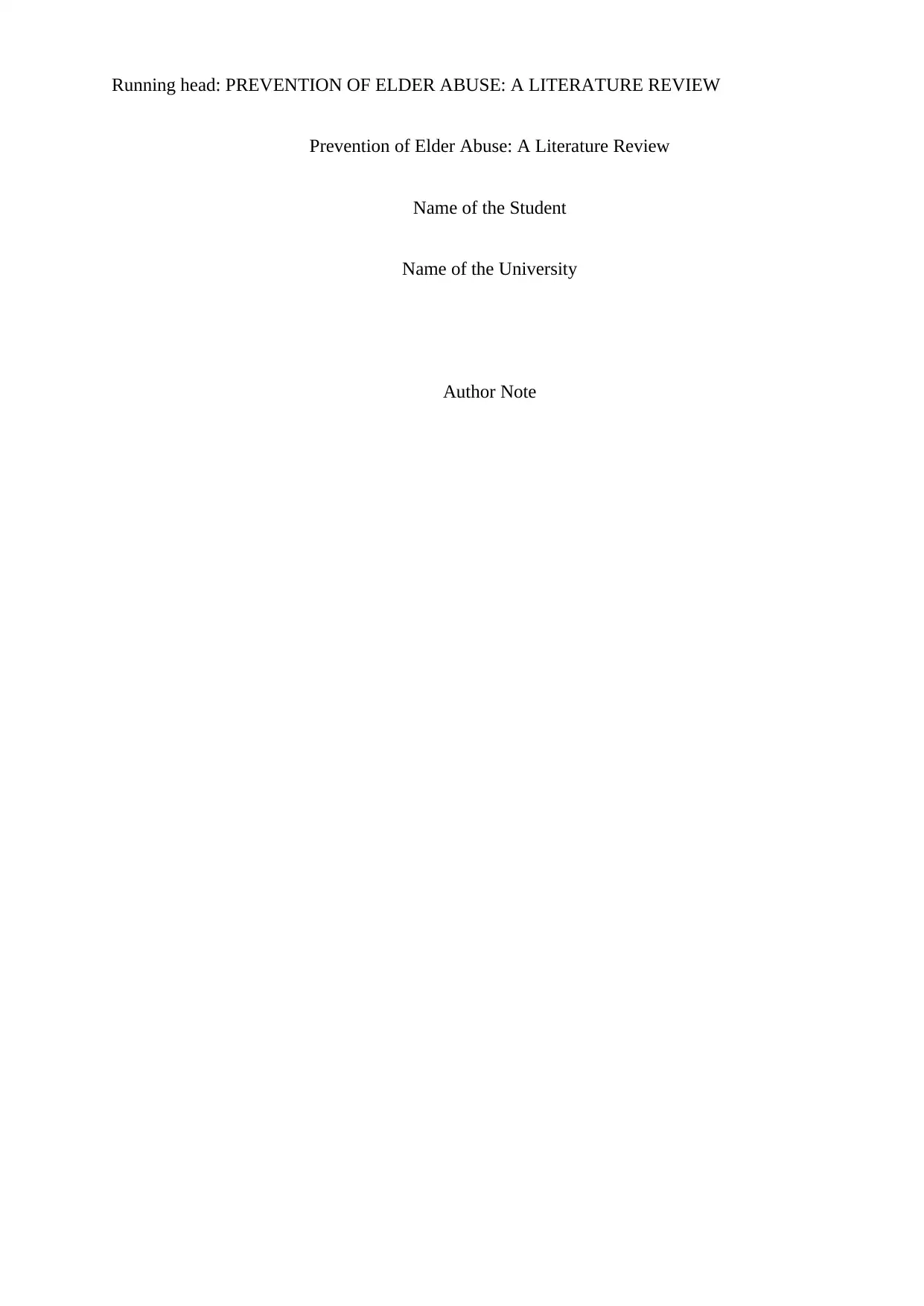
Running head: PREVENTION OF ELDER ABUSE: A LITERATURE REVIEW
Prevention of Elder Abuse: A Literature Review
Name of the Student
Name of the University
Author Note
Prevention of Elder Abuse: A Literature Review
Name of the Student
Name of the University
Author Note
Secure Best Marks with AI Grader
Need help grading? Try our AI Grader for instant feedback on your assignments.
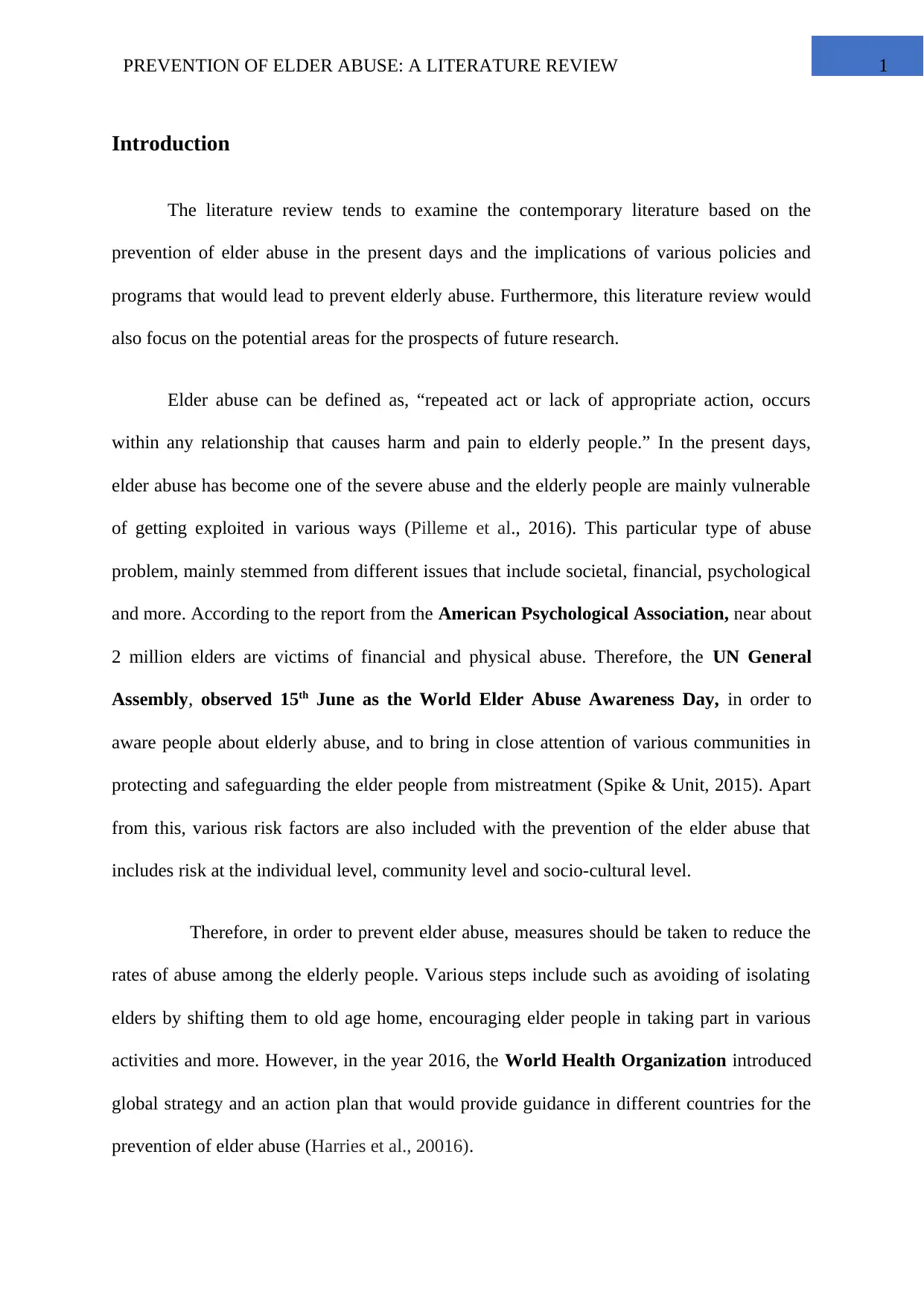
1PREVENTION OF ELDER ABUSE: A LITERATURE REVIEW
Introduction
The literature review tends to examine the contemporary literature based on the
prevention of elder abuse in the present days and the implications of various policies and
programs that would lead to prevent elderly abuse. Furthermore, this literature review would
also focus on the potential areas for the prospects of future research.
Elder abuse can be defined as, “repeated act or lack of appropriate action, occurs
within any relationship that causes harm and pain to elderly people.” In the present days,
elder abuse has become one of the severe abuse and the elderly people are mainly vulnerable
of getting exploited in various ways (Pilleme et al., 2016). This particular type of abuse
problem, mainly stemmed from different issues that include societal, financial, psychological
and more. According to the report from the American Psychological Association, near about
2 million elders are victims of financial and physical abuse. Therefore, the UN General
Assembly, observed 15th June as the World Elder Abuse Awareness Day, in order to
aware people about elderly abuse, and to bring in close attention of various communities in
protecting and safeguarding the elder people from mistreatment (Spike & Unit, 2015). Apart
from this, various risk factors are also included with the prevention of the elder abuse that
includes risk at the individual level, community level and socio-cultural level.
Therefore, in order to prevent elder abuse, measures should be taken to reduce the
rates of abuse among the elderly people. Various steps include such as avoiding of isolating
elders by shifting them to old age home, encouraging elder people in taking part in various
activities and more. However, in the year 2016, the World Health Organization introduced
global strategy and an action plan that would provide guidance in different countries for the
prevention of elder abuse (Harries et al., 20016).
Introduction
The literature review tends to examine the contemporary literature based on the
prevention of elder abuse in the present days and the implications of various policies and
programs that would lead to prevent elderly abuse. Furthermore, this literature review would
also focus on the potential areas for the prospects of future research.
Elder abuse can be defined as, “repeated act or lack of appropriate action, occurs
within any relationship that causes harm and pain to elderly people.” In the present days,
elder abuse has become one of the severe abuse and the elderly people are mainly vulnerable
of getting exploited in various ways (Pilleme et al., 2016). This particular type of abuse
problem, mainly stemmed from different issues that include societal, financial, psychological
and more. According to the report from the American Psychological Association, near about
2 million elders are victims of financial and physical abuse. Therefore, the UN General
Assembly, observed 15th June as the World Elder Abuse Awareness Day, in order to
aware people about elderly abuse, and to bring in close attention of various communities in
protecting and safeguarding the elder people from mistreatment (Spike & Unit, 2015). Apart
from this, various risk factors are also included with the prevention of the elder abuse that
includes risk at the individual level, community level and socio-cultural level.
Therefore, in order to prevent elder abuse, measures should be taken to reduce the
rates of abuse among the elderly people. Various steps include such as avoiding of isolating
elders by shifting them to old age home, encouraging elder people in taking part in various
activities and more. However, in the year 2016, the World Health Organization introduced
global strategy and an action plan that would provide guidance in different countries for the
prevention of elder abuse (Harries et al., 20016).
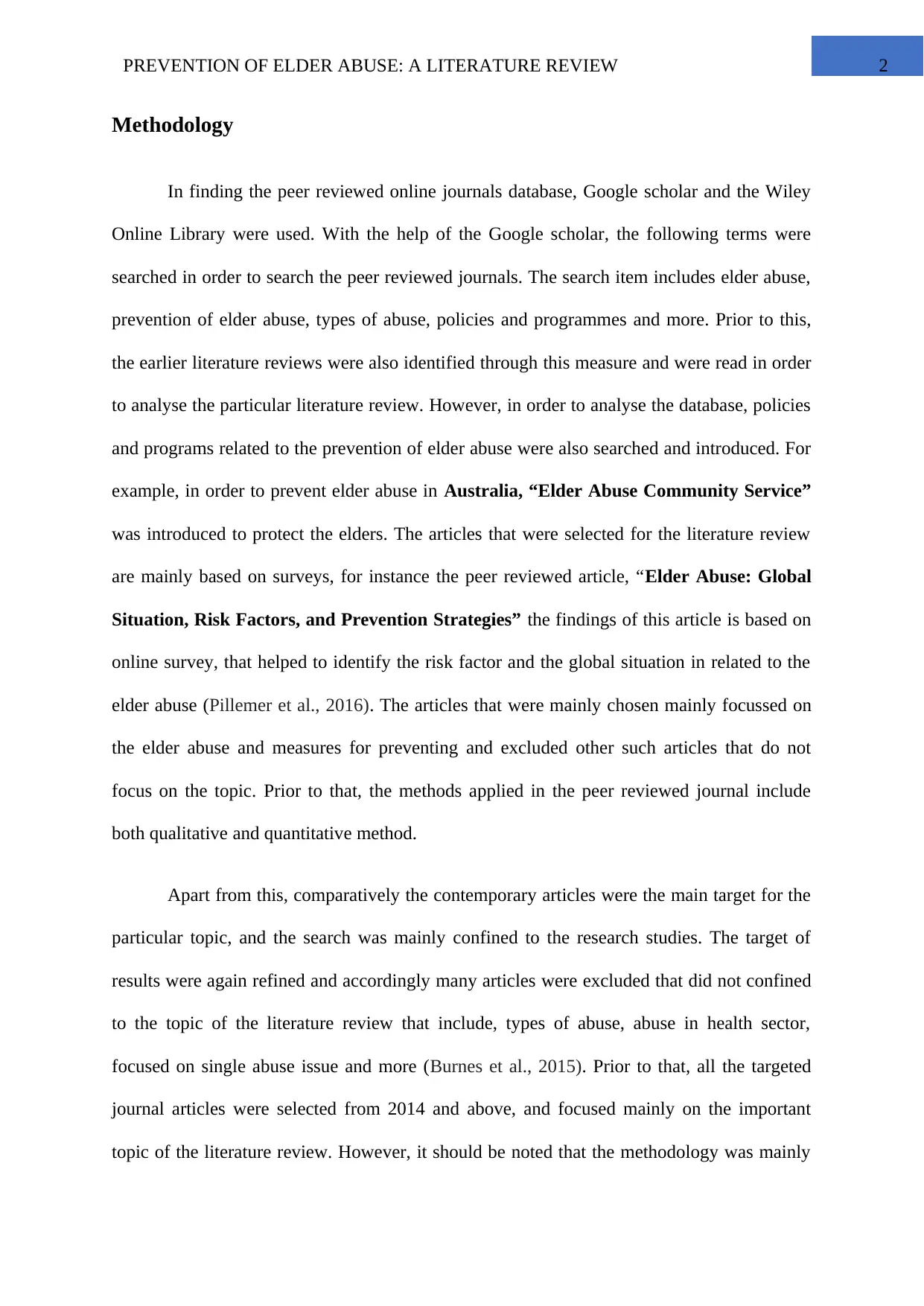
2PREVENTION OF ELDER ABUSE: A LITERATURE REVIEW
Methodology
In finding the peer reviewed online journals database, Google scholar and the Wiley
Online Library were used. With the help of the Google scholar, the following terms were
searched in order to search the peer reviewed journals. The search item includes elder abuse,
prevention of elder abuse, types of abuse, policies and programmes and more. Prior to this,
the earlier literature reviews were also identified through this measure and were read in order
to analyse the particular literature review. However, in order to analyse the database, policies
and programs related to the prevention of elder abuse were also searched and introduced. For
example, in order to prevent elder abuse in Australia, “Elder Abuse Community Service”
was introduced to protect the elders. The articles that were selected for the literature review
are mainly based on surveys, for instance the peer reviewed article, “Elder Abuse: Global
Situation, Risk Factors, and Prevention Strategies” the findings of this article is based on
online survey, that helped to identify the risk factor and the global situation in related to the
elder abuse (Pillemer et al., 2016). The articles that were mainly chosen mainly focussed on
the elder abuse and measures for preventing and excluded other such articles that do not
focus on the topic. Prior to that, the methods applied in the peer reviewed journal include
both qualitative and quantitative method.
Apart from this, comparatively the contemporary articles were the main target for the
particular topic, and the search was mainly confined to the research studies. The target of
results were again refined and accordingly many articles were excluded that did not confined
to the topic of the literature review that include, types of abuse, abuse in health sector,
focused on single abuse issue and more (Burnes et al., 2015). Prior to that, all the targeted
journal articles were selected from 2014 and above, and focused mainly on the important
topic of the literature review. However, it should be noted that the methodology was mainly
Methodology
In finding the peer reviewed online journals database, Google scholar and the Wiley
Online Library were used. With the help of the Google scholar, the following terms were
searched in order to search the peer reviewed journals. The search item includes elder abuse,
prevention of elder abuse, types of abuse, policies and programmes and more. Prior to this,
the earlier literature reviews were also identified through this measure and were read in order
to analyse the particular literature review. However, in order to analyse the database, policies
and programs related to the prevention of elder abuse were also searched and introduced. For
example, in order to prevent elder abuse in Australia, “Elder Abuse Community Service”
was introduced to protect the elders. The articles that were selected for the literature review
are mainly based on surveys, for instance the peer reviewed article, “Elder Abuse: Global
Situation, Risk Factors, and Prevention Strategies” the findings of this article is based on
online survey, that helped to identify the risk factor and the global situation in related to the
elder abuse (Pillemer et al., 2016). The articles that were mainly chosen mainly focussed on
the elder abuse and measures for preventing and excluded other such articles that do not
focus on the topic. Prior to that, the methods applied in the peer reviewed journal include
both qualitative and quantitative method.
Apart from this, comparatively the contemporary articles were the main target for the
particular topic, and the search was mainly confined to the research studies. The target of
results were again refined and accordingly many articles were excluded that did not confined
to the topic of the literature review that include, types of abuse, abuse in health sector,
focused on single abuse issue and more (Burnes et al., 2015). Prior to that, all the targeted
journal articles were selected from 2014 and above, and focused mainly on the important
topic of the literature review. However, it should be noted that the methodology was mainly
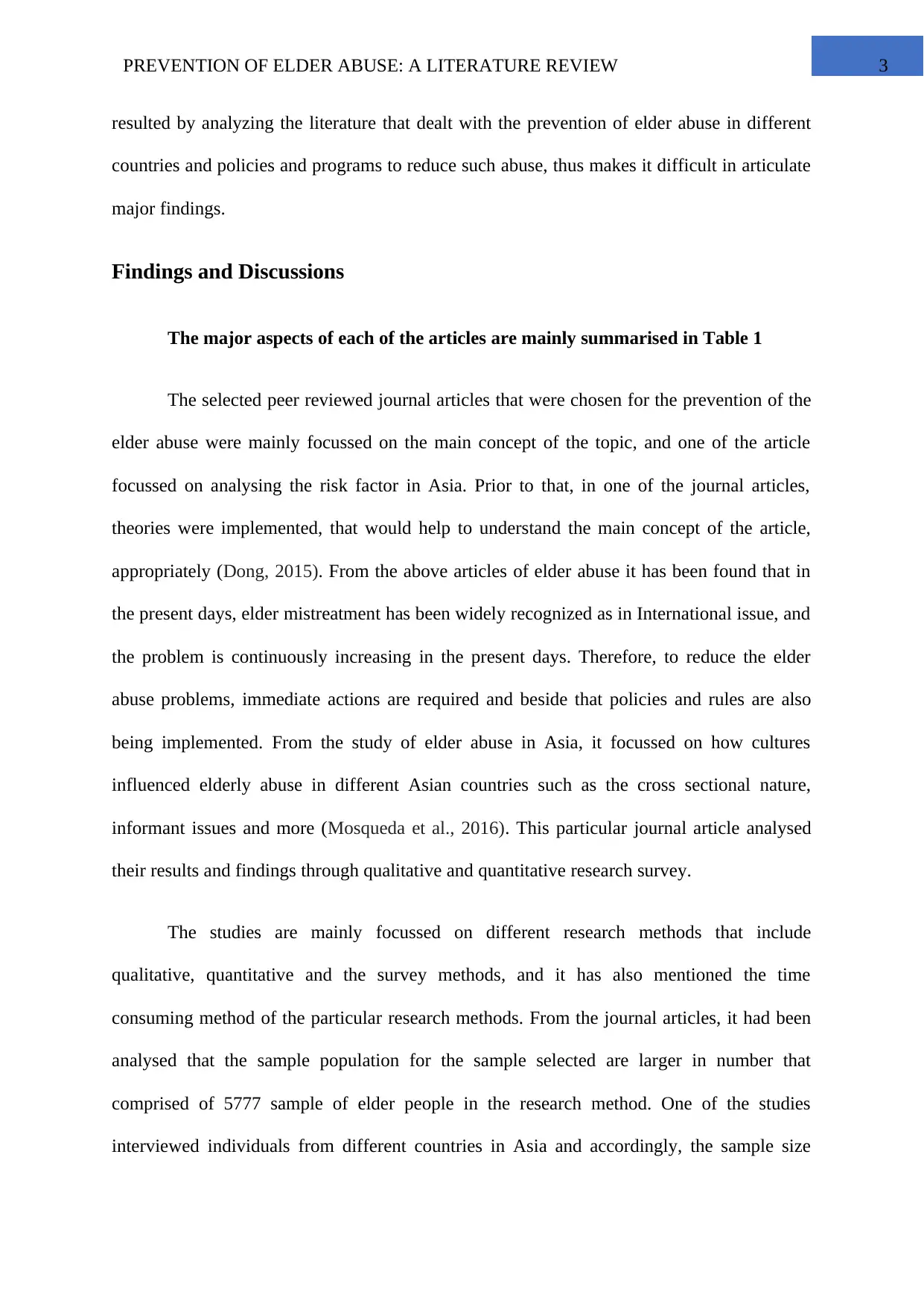
3PREVENTION OF ELDER ABUSE: A LITERATURE REVIEW
resulted by analyzing the literature that dealt with the prevention of elder abuse in different
countries and policies and programs to reduce such abuse, thus makes it difficult in articulate
major findings.
Findings and Discussions
The major aspects of each of the articles are mainly summarised in Table 1
The selected peer reviewed journal articles that were chosen for the prevention of the
elder abuse were mainly focussed on the main concept of the topic, and one of the article
focussed on analysing the risk factor in Asia. Prior to that, in one of the journal articles,
theories were implemented, that would help to understand the main concept of the article,
appropriately (Dong, 2015). From the above articles of elder abuse it has been found that in
the present days, elder mistreatment has been widely recognized as in International issue, and
the problem is continuously increasing in the present days. Therefore, to reduce the elder
abuse problems, immediate actions are required and beside that policies and rules are also
being implemented. From the study of elder abuse in Asia, it focussed on how cultures
influenced elderly abuse in different Asian countries such as the cross sectional nature,
informant issues and more (Mosqueda et al., 2016). This particular journal article analysed
their results and findings through qualitative and quantitative research survey.
The studies are mainly focussed on different research methods that include
qualitative, quantitative and the survey methods, and it has also mentioned the time
consuming method of the particular research methods. From the journal articles, it had been
analysed that the sample population for the sample selected are larger in number that
comprised of 5777 sample of elder people in the research method. One of the studies
interviewed individuals from different countries in Asia and accordingly, the sample size
resulted by analyzing the literature that dealt with the prevention of elder abuse in different
countries and policies and programs to reduce such abuse, thus makes it difficult in articulate
major findings.
Findings and Discussions
The major aspects of each of the articles are mainly summarised in Table 1
The selected peer reviewed journal articles that were chosen for the prevention of the
elder abuse were mainly focussed on the main concept of the topic, and one of the article
focussed on analysing the risk factor in Asia. Prior to that, in one of the journal articles,
theories were implemented, that would help to understand the main concept of the article,
appropriately (Dong, 2015). From the above articles of elder abuse it has been found that in
the present days, elder mistreatment has been widely recognized as in International issue, and
the problem is continuously increasing in the present days. Therefore, to reduce the elder
abuse problems, immediate actions are required and beside that policies and rules are also
being implemented. From the study of elder abuse in Asia, it focussed on how cultures
influenced elderly abuse in different Asian countries such as the cross sectional nature,
informant issues and more (Mosqueda et al., 2016). This particular journal article analysed
their results and findings through qualitative and quantitative research survey.
The studies are mainly focussed on different research methods that include
qualitative, quantitative and the survey methods, and it has also mentioned the time
consuming method of the particular research methods. From the journal articles, it had been
analysed that the sample population for the sample selected are larger in number that
comprised of 5777 sample of elder people in the research method. One of the studies
interviewed individuals from different countries in Asia and accordingly, the sample size
Secure Best Marks with AI Grader
Need help grading? Try our AI Grader for instant feedback on your assignments.
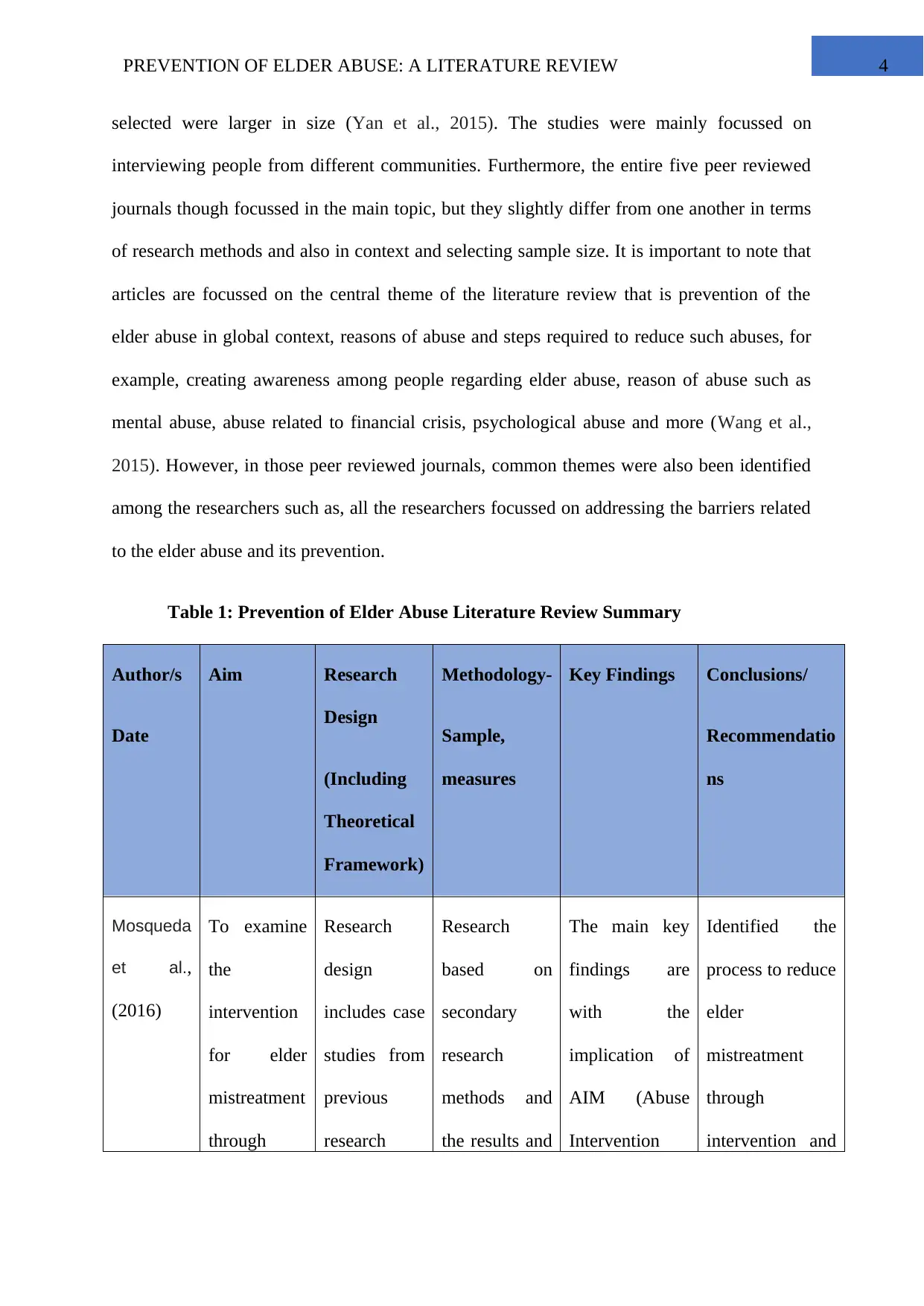
4PREVENTION OF ELDER ABUSE: A LITERATURE REVIEW
selected were larger in size (Yan et al., 2015). The studies were mainly focussed on
interviewing people from different communities. Furthermore, the entire five peer reviewed
journals though focussed in the main topic, but they slightly differ from one another in terms
of research methods and also in context and selecting sample size. It is important to note that
articles are focussed on the central theme of the literature review that is prevention of the
elder abuse in global context, reasons of abuse and steps required to reduce such abuses, for
example, creating awareness among people regarding elder abuse, reason of abuse such as
mental abuse, abuse related to financial crisis, psychological abuse and more (Wang et al.,
2015). However, in those peer reviewed journals, common themes were also been identified
among the researchers such as, all the researchers focussed on addressing the barriers related
to the elder abuse and its prevention.
Table 1: Prevention of Elder Abuse Literature Review Summary
Author/s
Date
Aim Research
Design
(Including
Theoretical
Framework)
Methodology-
Sample,
measures
Key Findings Conclusions/
Recommendatio
ns
Mosqueda
et al.,
(2016)
To examine
the
intervention
for elder
mistreatment
through
Research
design
includes case
studies from
previous
research
Research
based on
secondary
research
methods and
the results and
The main key
findings are
with the
implication of
AIM (Abuse
Intervention
Identified the
process to reduce
elder
mistreatment
through
intervention and
selected were larger in size (Yan et al., 2015). The studies were mainly focussed on
interviewing people from different communities. Furthermore, the entire five peer reviewed
journals though focussed in the main topic, but they slightly differ from one another in terms
of research methods and also in context and selecting sample size. It is important to note that
articles are focussed on the central theme of the literature review that is prevention of the
elder abuse in global context, reasons of abuse and steps required to reduce such abuses, for
example, creating awareness among people regarding elder abuse, reason of abuse such as
mental abuse, abuse related to financial crisis, psychological abuse and more (Wang et al.,
2015). However, in those peer reviewed journals, common themes were also been identified
among the researchers such as, all the researchers focussed on addressing the barriers related
to the elder abuse and its prevention.
Table 1: Prevention of Elder Abuse Literature Review Summary
Author/s
Date
Aim Research
Design
(Including
Theoretical
Framework)
Methodology-
Sample,
measures
Key Findings Conclusions/
Recommendatio
ns
Mosqueda
et al.,
(2016)
To examine
the
intervention
for elder
mistreatment
through
Research
design
includes case
studies from
previous
research
Research
based on
secondary
research
methods and
the results and
The main key
findings are
with the
implication of
AIM (Abuse
Intervention
Identified the
process to reduce
elder
mistreatment
through
intervention and
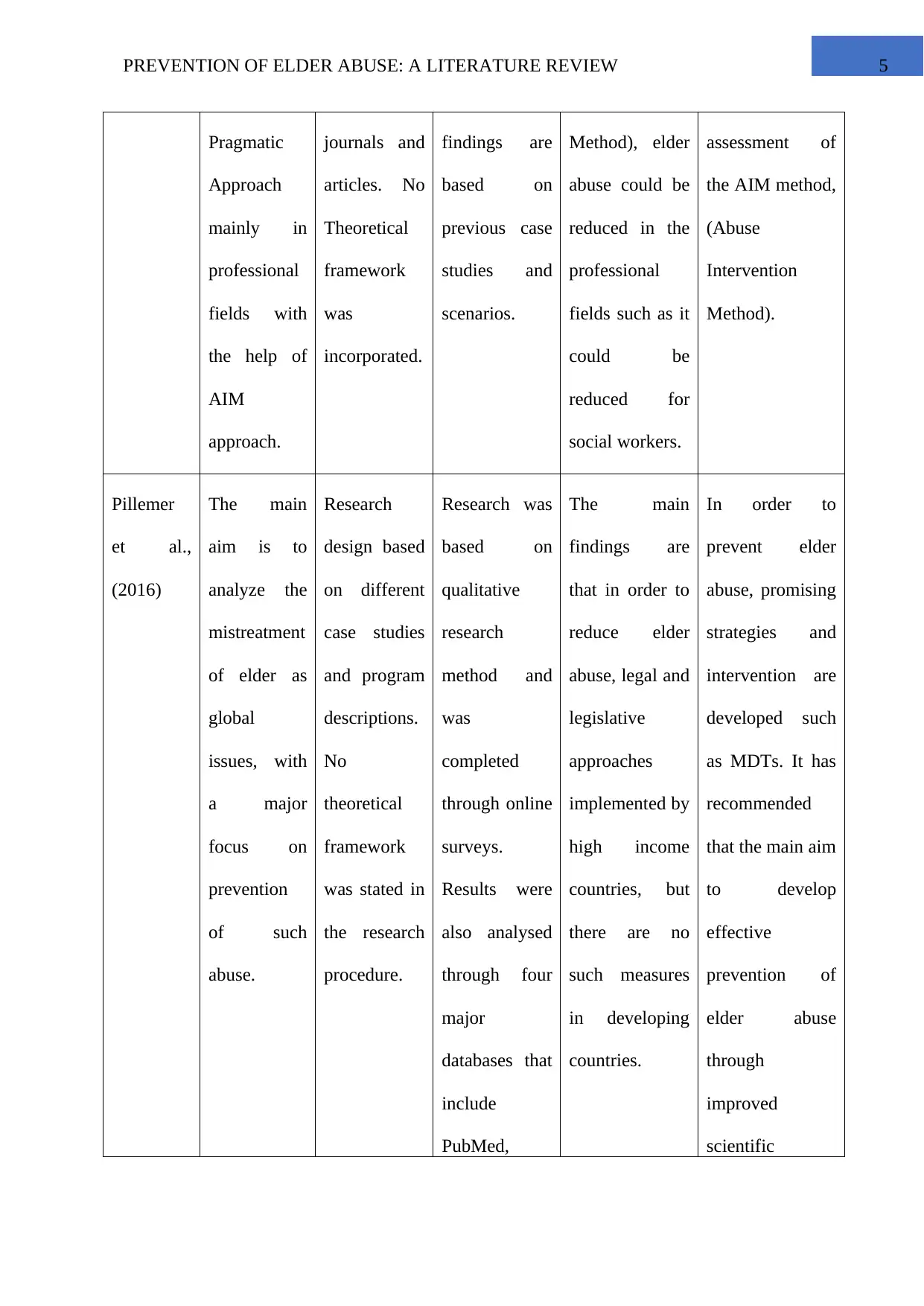
5PREVENTION OF ELDER ABUSE: A LITERATURE REVIEW
Pragmatic
Approach
mainly in
professional
fields with
the help of
AIM
approach.
journals and
articles. No
Theoretical
framework
was
incorporated.
findings are
based on
previous case
studies and
scenarios.
Method), elder
abuse could be
reduced in the
professional
fields such as it
could be
reduced for
social workers.
assessment of
the AIM method,
(Abuse
Intervention
Method).
Pillemer
et al.,
(2016)
The main
aim is to
analyze the
mistreatment
of elder as
global
issues, with
a major
focus on
prevention
of such
abuse.
Research
design based
on different
case studies
and program
descriptions.
No
theoretical
framework
was stated in
the research
procedure.
Research was
based on
qualitative
research
method and
was
completed
through online
surveys.
Results were
also analysed
through four
major
databases that
include
PubMed,
The main
findings are
that in order to
reduce elder
abuse, legal and
legislative
approaches
implemented by
high income
countries, but
there are no
such measures
in developing
countries.
In order to
prevent elder
abuse, promising
strategies and
intervention are
developed such
as MDTs. It has
recommended
that the main aim
to develop
effective
prevention of
elder abuse
through
improved
scientific
Pragmatic
Approach
mainly in
professional
fields with
the help of
AIM
approach.
journals and
articles. No
Theoretical
framework
was
incorporated.
findings are
based on
previous case
studies and
scenarios.
Method), elder
abuse could be
reduced in the
professional
fields such as it
could be
reduced for
social workers.
assessment of
the AIM method,
(Abuse
Intervention
Method).
Pillemer
et al.,
(2016)
The main
aim is to
analyze the
mistreatment
of elder as
global
issues, with
a major
focus on
prevention
of such
abuse.
Research
design based
on different
case studies
and program
descriptions.
No
theoretical
framework
was stated in
the research
procedure.
Research was
based on
qualitative
research
method and
was
completed
through online
surveys.
Results were
also analysed
through four
major
databases that
include
PubMed,
The main
findings are
that in order to
reduce elder
abuse, legal and
legislative
approaches
implemented by
high income
countries, but
there are no
such measures
in developing
countries.
In order to
prevent elder
abuse, promising
strategies and
intervention are
developed such
as MDTs. It has
recommended
that the main aim
to develop
effective
prevention of
elder abuse
through
improved
scientific
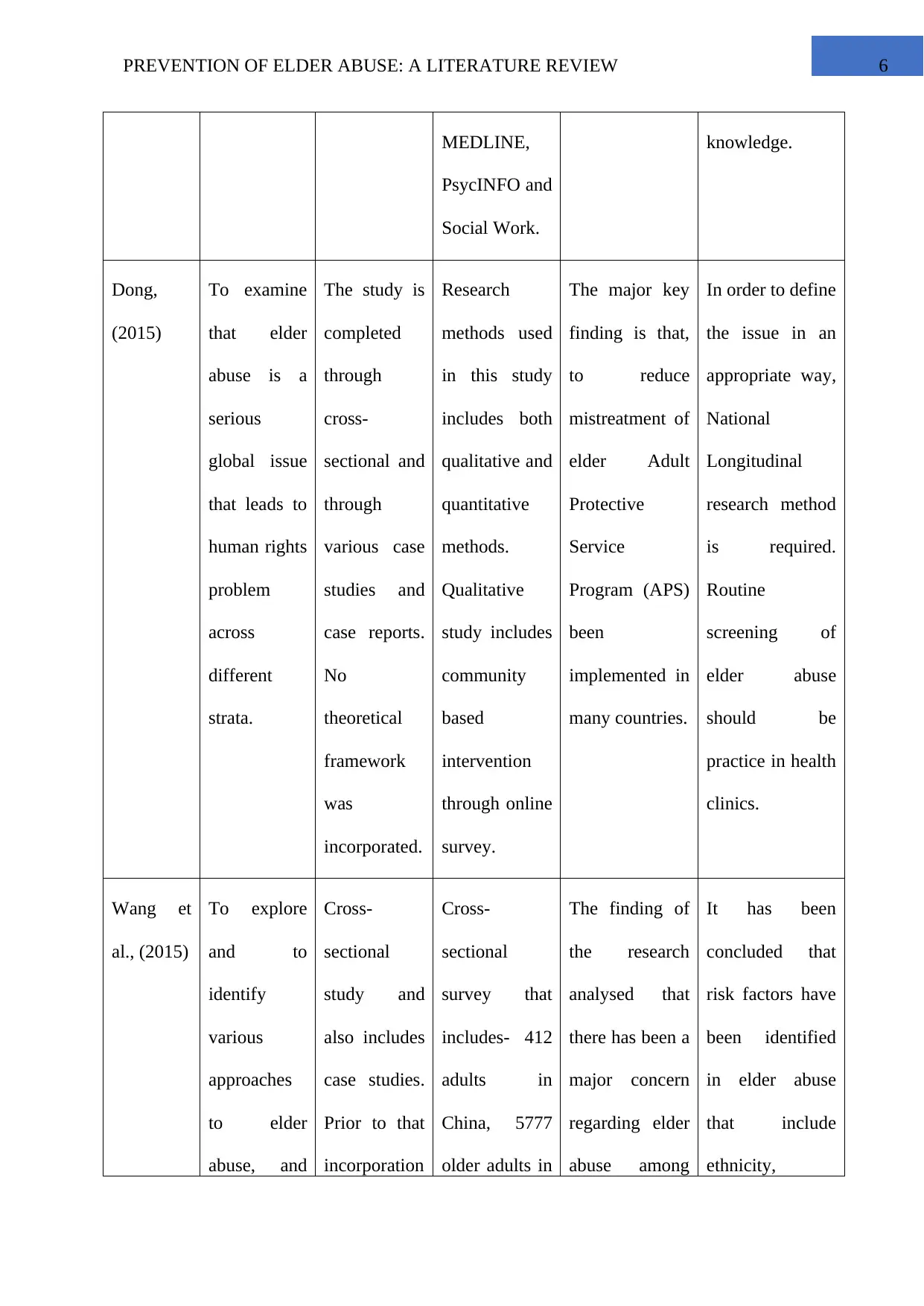
6PREVENTION OF ELDER ABUSE: A LITERATURE REVIEW
MEDLINE,
PsycINFO and
Social Work.
knowledge.
Dong,
(2015)
To examine
that elder
abuse is a
serious
global issue
that leads to
human rights
problem
across
different
strata.
The study is
completed
through
cross-
sectional and
through
various case
studies and
case reports.
No
theoretical
framework
was
incorporated.
Research
methods used
in this study
includes both
qualitative and
quantitative
methods.
Qualitative
study includes
community
based
intervention
through online
survey.
The major key
finding is that,
to reduce
mistreatment of
elder Adult
Protective
Service
Program (APS)
been
implemented in
many countries.
In order to define
the issue in an
appropriate way,
National
Longitudinal
research method
is required.
Routine
screening of
elder abuse
should be
practice in health
clinics.
Wang et
al., (2015)
To explore
and to
identify
various
approaches
to elder
abuse, and
Cross-
sectional
study and
also includes
case studies.
Prior to that
incorporation
Cross-
sectional
survey that
includes- 412
adults in
China, 5777
older adults in
The finding of
the research
analysed that
there has been a
major concern
regarding elder
abuse among
It has been
concluded that
risk factors have
been identified
in elder abuse
that include
ethnicity,
MEDLINE,
PsycINFO and
Social Work.
knowledge.
Dong,
(2015)
To examine
that elder
abuse is a
serious
global issue
that leads to
human rights
problem
across
different
strata.
The study is
completed
through
cross-
sectional and
through
various case
studies and
case reports.
No
theoretical
framework
was
incorporated.
Research
methods used
in this study
includes both
qualitative and
quantitative
methods.
Qualitative
study includes
community
based
intervention
through online
survey.
The major key
finding is that,
to reduce
mistreatment of
elder Adult
Protective
Service
Program (APS)
been
implemented in
many countries.
In order to define
the issue in an
appropriate way,
National
Longitudinal
research method
is required.
Routine
screening of
elder abuse
should be
practice in health
clinics.
Wang et
al., (2015)
To explore
and to
identify
various
approaches
to elder
abuse, and
Cross-
sectional
study and
also includes
case studies.
Prior to that
incorporation
Cross-
sectional
survey that
includes- 412
adults in
China, 5777
older adults in
The finding of
the research
analysed that
there has been a
major concern
regarding elder
abuse among
It has been
concluded that
risk factors have
been identified
in elder abuse
that include
ethnicity,
Paraphrase This Document
Need a fresh take? Get an instant paraphrase of this document with our AI Paraphraser
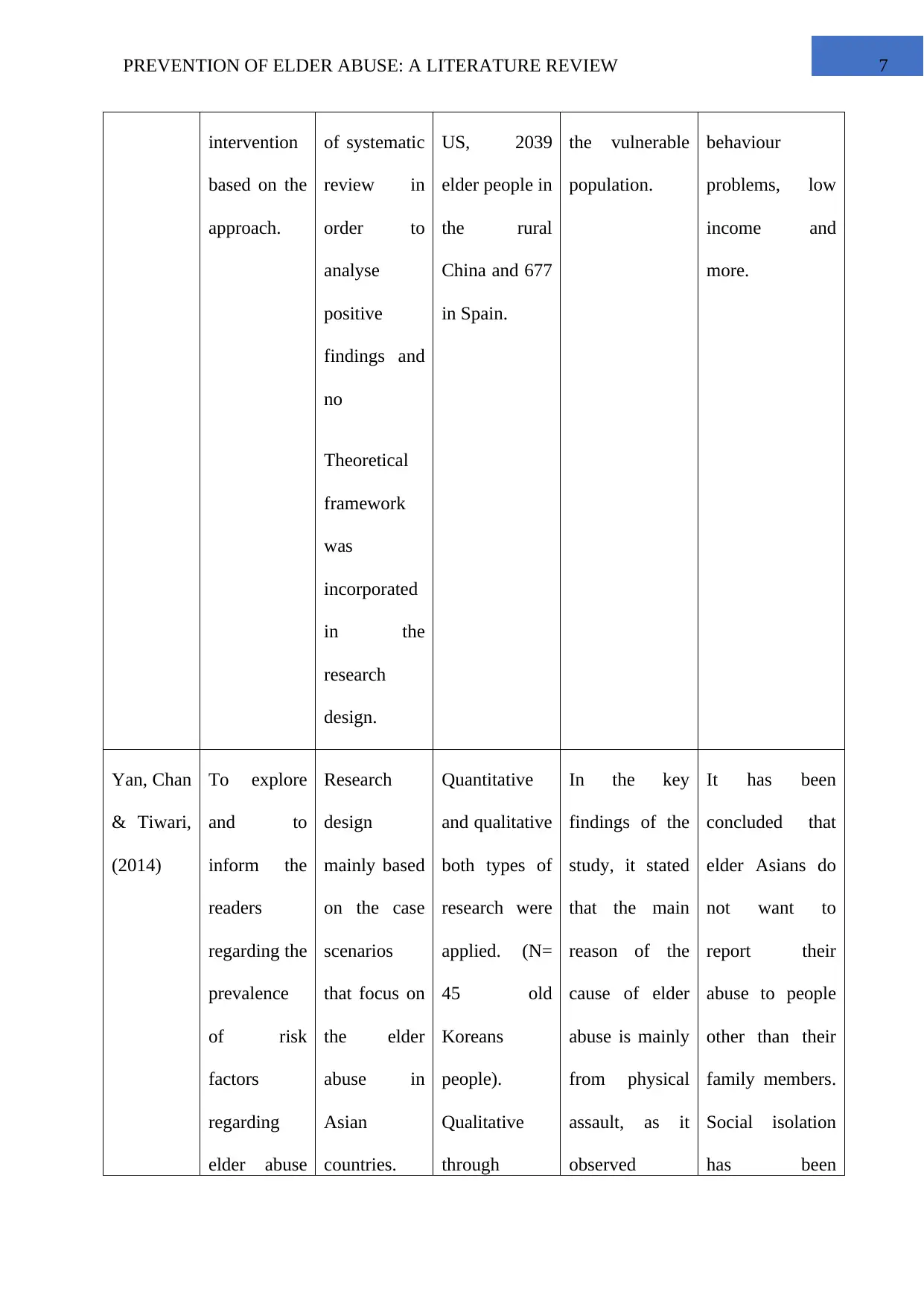
7PREVENTION OF ELDER ABUSE: A LITERATURE REVIEW
intervention
based on the
approach.
of systematic
review in
order to
analyse
positive
findings and
no
Theoretical
framework
was
incorporated
in the
research
design.
US, 2039
elder people in
the rural
China and 677
in Spain.
the vulnerable
population.
behaviour
problems, low
income and
more.
Yan, Chan
& Tiwari,
(2014)
To explore
and to
inform the
readers
regarding the
prevalence
of risk
factors
regarding
elder abuse
Research
design
mainly based
on the case
scenarios
that focus on
the elder
abuse in
Asian
countries.
Quantitative
and qualitative
both types of
research were
applied. (N=
45 old
Koreans
people).
Qualitative
through
In the key
findings of the
study, it stated
that the main
reason of the
cause of elder
abuse is mainly
from physical
assault, as it
observed
It has been
concluded that
elder Asians do
not want to
report their
abuse to people
other than their
family members.
Social isolation
has been
intervention
based on the
approach.
of systematic
review in
order to
analyse
positive
findings and
no
Theoretical
framework
was
incorporated
in the
research
design.
US, 2039
elder people in
the rural
China and 677
in Spain.
the vulnerable
population.
behaviour
problems, low
income and
more.
Yan, Chan
& Tiwari,
(2014)
To explore
and to
inform the
readers
regarding the
prevalence
of risk
factors
regarding
elder abuse
Research
design
mainly based
on the case
scenarios
that focus on
the elder
abuse in
Asian
countries.
Quantitative
and qualitative
both types of
research were
applied. (N=
45 old
Koreans
people).
Qualitative
through
In the key
findings of the
study, it stated
that the main
reason of the
cause of elder
abuse is mainly
from physical
assault, as it
observed
It has been
concluded that
elder Asians do
not want to
report their
abuse to people
other than their
family members.
Social isolation
has been
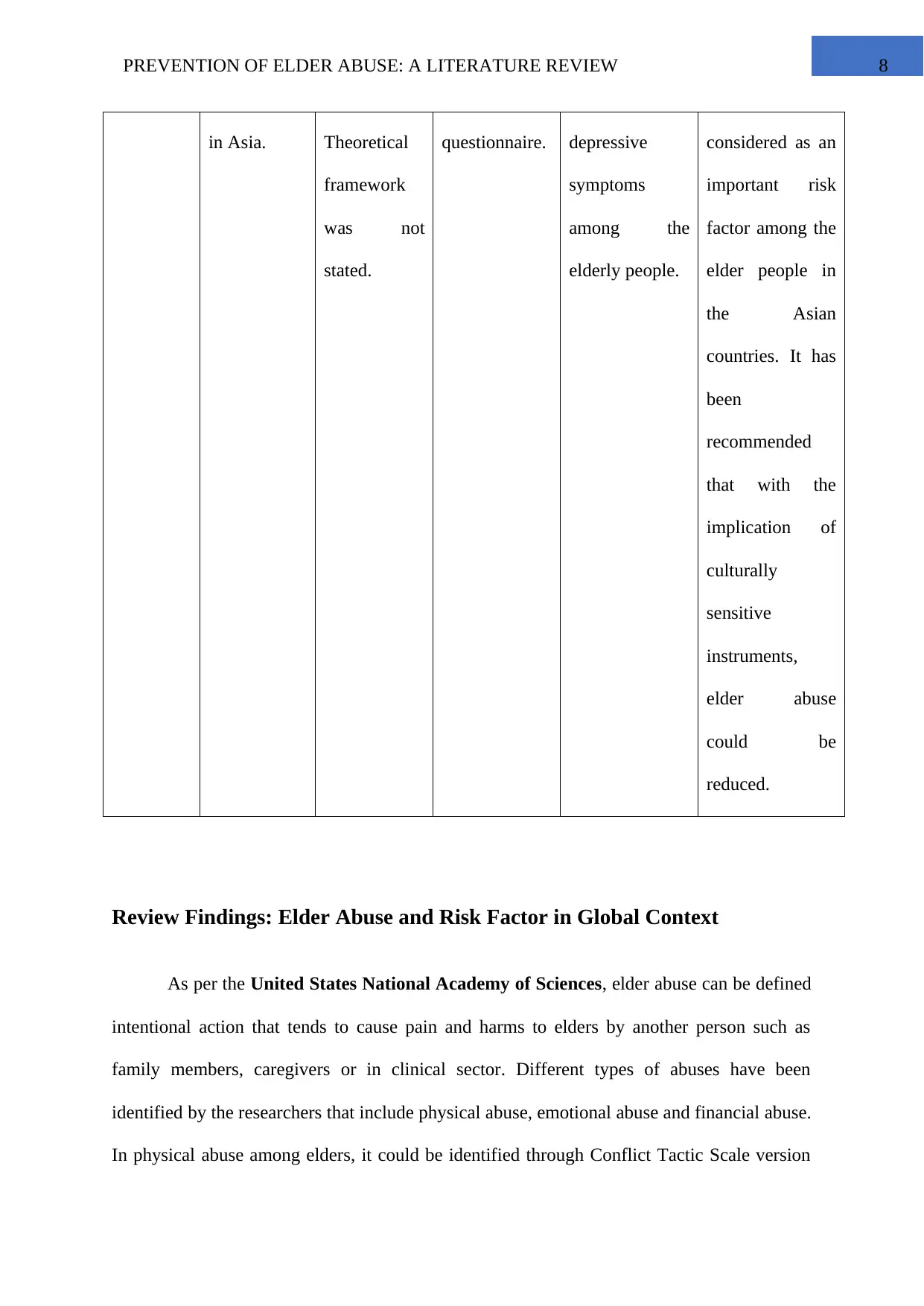
8PREVENTION OF ELDER ABUSE: A LITERATURE REVIEW
in Asia. Theoretical
framework
was not
stated.
questionnaire. depressive
symptoms
among the
elderly people.
considered as an
important risk
factor among the
elder people in
the Asian
countries. It has
been
recommended
that with the
implication of
culturally
sensitive
instruments,
elder abuse
could be
reduced.
Review Findings: Elder Abuse and Risk Factor in Global Context
As per the United States National Academy of Sciences, elder abuse can be defined
intentional action that tends to cause pain and harms to elders by another person such as
family members, caregivers or in clinical sector. Different types of abuses have been
identified by the researchers that include physical abuse, emotional abuse and financial abuse.
In physical abuse among elders, it could be identified through Conflict Tactic Scale version
in Asia. Theoretical
framework
was not
stated.
questionnaire. depressive
symptoms
among the
elderly people.
considered as an
important risk
factor among the
elder people in
the Asian
countries. It has
been
recommended
that with the
implication of
culturally
sensitive
instruments,
elder abuse
could be
reduced.
Review Findings: Elder Abuse and Risk Factor in Global Context
As per the United States National Academy of Sciences, elder abuse can be defined
intentional action that tends to cause pain and harms to elders by another person such as
family members, caregivers or in clinical sector. Different types of abuses have been
identified by the researchers that include physical abuse, emotional abuse and financial abuse.
In physical abuse among elders, it could be identified through Conflict Tactic Scale version
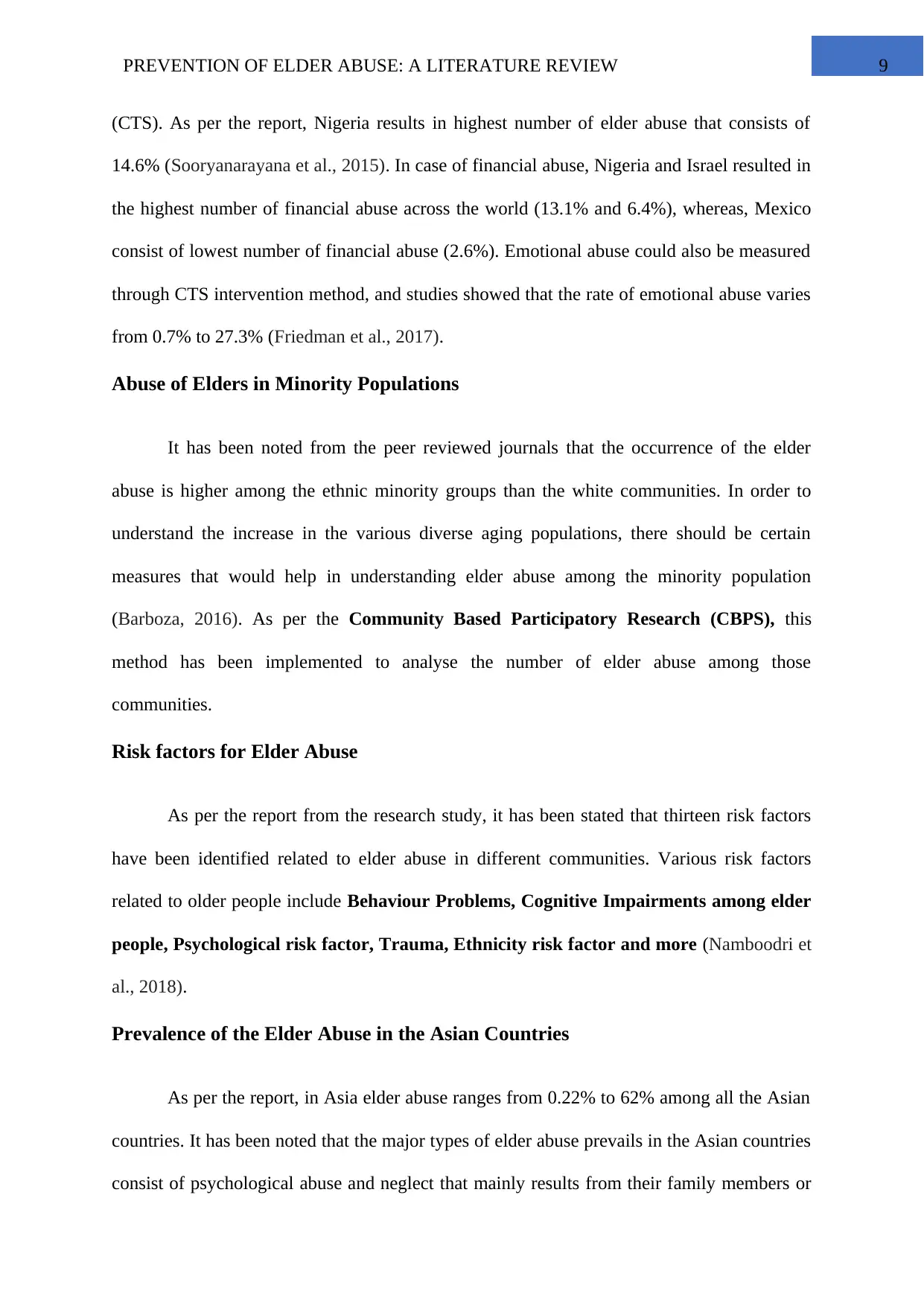
9PREVENTION OF ELDER ABUSE: A LITERATURE REVIEW
(CTS). As per the report, Nigeria results in highest number of elder abuse that consists of
14.6% (Sooryanarayana et al., 2015). In case of financial abuse, Nigeria and Israel resulted in
the highest number of financial abuse across the world (13.1% and 6.4%), whereas, Mexico
consist of lowest number of financial abuse (2.6%). Emotional abuse could also be measured
through CTS intervention method, and studies showed that the rate of emotional abuse varies
from 0.7% to 27.3% (Friedman et al., 2017).
Abuse of Elders in Minority Populations
It has been noted from the peer reviewed journals that the occurrence of the elder
abuse is higher among the ethnic minority groups than the white communities. In order to
understand the increase in the various diverse aging populations, there should be certain
measures that would help in understanding elder abuse among the minority population
(Barboza, 2016). As per the Community Based Participatory Research (CBPS), this
method has been implemented to analyse the number of elder abuse among those
communities.
Risk factors for Elder Abuse
As per the report from the research study, it has been stated that thirteen risk factors
have been identified related to elder abuse in different communities. Various risk factors
related to older people include Behaviour Problems, Cognitive Impairments among elder
people, Psychological risk factor, Trauma, Ethnicity risk factor and more (Namboodri et
al., 2018).
Prevalence of the Elder Abuse in the Asian Countries
As per the report, in Asia elder abuse ranges from 0.22% to 62% among all the Asian
countries. It has been noted that the major types of elder abuse prevails in the Asian countries
consist of psychological abuse and neglect that mainly results from their family members or
(CTS). As per the report, Nigeria results in highest number of elder abuse that consists of
14.6% (Sooryanarayana et al., 2015). In case of financial abuse, Nigeria and Israel resulted in
the highest number of financial abuse across the world (13.1% and 6.4%), whereas, Mexico
consist of lowest number of financial abuse (2.6%). Emotional abuse could also be measured
through CTS intervention method, and studies showed that the rate of emotional abuse varies
from 0.7% to 27.3% (Friedman et al., 2017).
Abuse of Elders in Minority Populations
It has been noted from the peer reviewed journals that the occurrence of the elder
abuse is higher among the ethnic minority groups than the white communities. In order to
understand the increase in the various diverse aging populations, there should be certain
measures that would help in understanding elder abuse among the minority population
(Barboza, 2016). As per the Community Based Participatory Research (CBPS), this
method has been implemented to analyse the number of elder abuse among those
communities.
Risk factors for Elder Abuse
As per the report from the research study, it has been stated that thirteen risk factors
have been identified related to elder abuse in different communities. Various risk factors
related to older people include Behaviour Problems, Cognitive Impairments among elder
people, Psychological risk factor, Trauma, Ethnicity risk factor and more (Namboodri et
al., 2018).
Prevalence of the Elder Abuse in the Asian Countries
As per the report, in Asia elder abuse ranges from 0.22% to 62% among all the Asian
countries. It has been noted that the major types of elder abuse prevails in the Asian countries
consist of psychological abuse and neglect that mainly results from their family members or
Secure Best Marks with AI Grader
Need help grading? Try our AI Grader for instant feedback on your assignments.
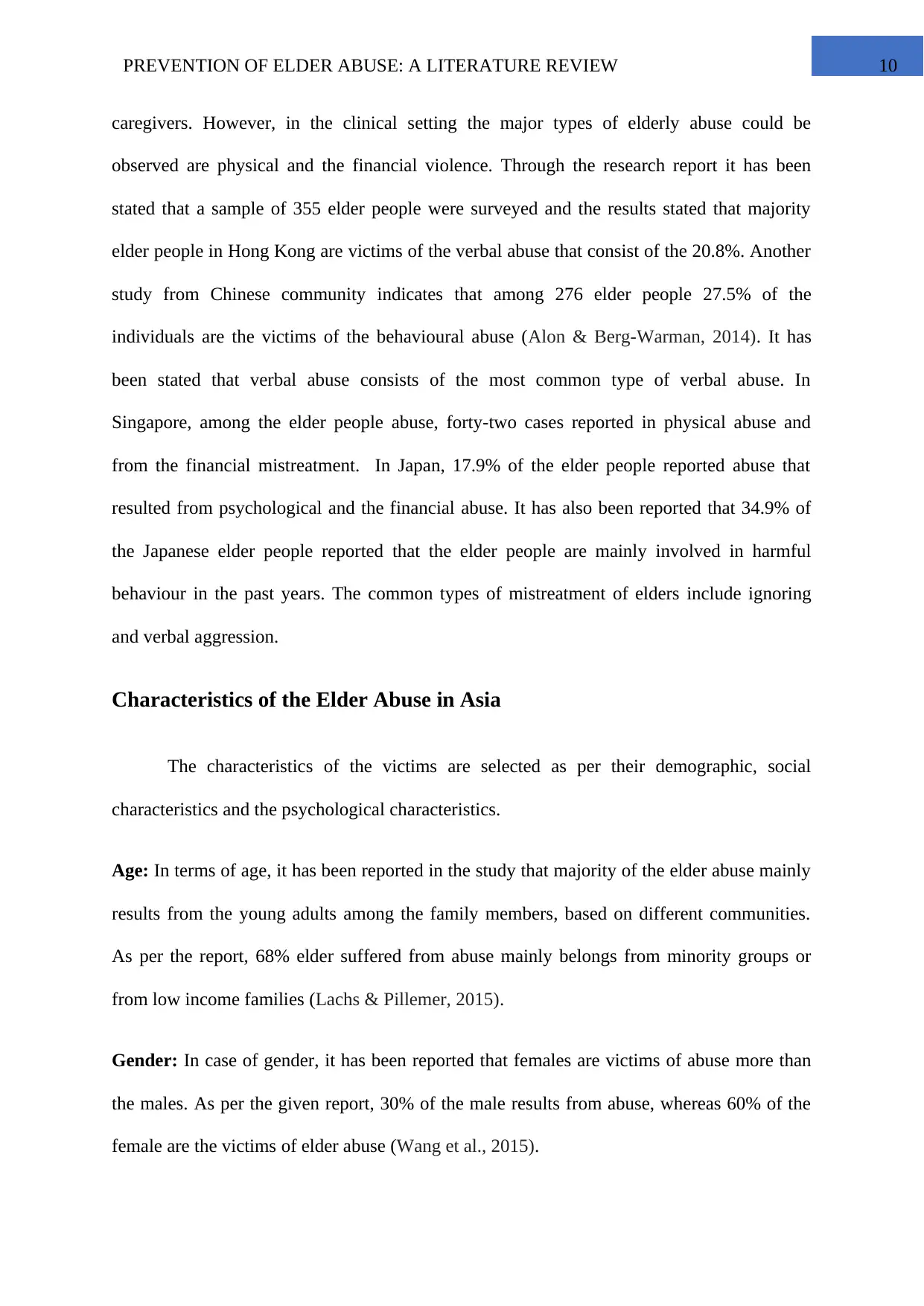
10PREVENTION OF ELDER ABUSE: A LITERATURE REVIEW
caregivers. However, in the clinical setting the major types of elderly abuse could be
observed are physical and the financial violence. Through the research report it has been
stated that a sample of 355 elder people were surveyed and the results stated that majority
elder people in Hong Kong are victims of the verbal abuse that consist of the 20.8%. Another
study from Chinese community indicates that among 276 elder people 27.5% of the
individuals are the victims of the behavioural abuse (Alon & Berg-Warman, 2014). It has
been stated that verbal abuse consists of the most common type of verbal abuse. In
Singapore, among the elder people abuse, forty-two cases reported in physical abuse and
from the financial mistreatment. In Japan, 17.9% of the elder people reported abuse that
resulted from psychological and the financial abuse. It has also been reported that 34.9% of
the Japanese elder people reported that the elder people are mainly involved in harmful
behaviour in the past years. The common types of mistreatment of elders include ignoring
and verbal aggression.
Characteristics of the Elder Abuse in Asia
The characteristics of the victims are selected as per their demographic, social
characteristics and the psychological characteristics.
Age: In terms of age, it has been reported in the study that majority of the elder abuse mainly
results from the young adults among the family members, based on different communities.
As per the report, 68% elder suffered from abuse mainly belongs from minority groups or
from low income families (Lachs & Pillemer, 2015).
Gender: In case of gender, it has been reported that females are victims of abuse more than
the males. As per the given report, 30% of the male results from abuse, whereas 60% of the
female are the victims of elder abuse (Wang et al., 2015).
caregivers. However, in the clinical setting the major types of elderly abuse could be
observed are physical and the financial violence. Through the research report it has been
stated that a sample of 355 elder people were surveyed and the results stated that majority
elder people in Hong Kong are victims of the verbal abuse that consist of the 20.8%. Another
study from Chinese community indicates that among 276 elder people 27.5% of the
individuals are the victims of the behavioural abuse (Alon & Berg-Warman, 2014). It has
been stated that verbal abuse consists of the most common type of verbal abuse. In
Singapore, among the elder people abuse, forty-two cases reported in physical abuse and
from the financial mistreatment. In Japan, 17.9% of the elder people reported abuse that
resulted from psychological and the financial abuse. It has also been reported that 34.9% of
the Japanese elder people reported that the elder people are mainly involved in harmful
behaviour in the past years. The common types of mistreatment of elders include ignoring
and verbal aggression.
Characteristics of the Elder Abuse in Asia
The characteristics of the victims are selected as per their demographic, social
characteristics and the psychological characteristics.
Age: In terms of age, it has been reported in the study that majority of the elder abuse mainly
results from the young adults among the family members, based on different communities.
As per the report, 68% elder suffered from abuse mainly belongs from minority groups or
from low income families (Lachs & Pillemer, 2015).
Gender: In case of gender, it has been reported that females are victims of abuse more than
the males. As per the given report, 30% of the male results from abuse, whereas 60% of the
female are the victims of elder abuse (Wang et al., 2015).
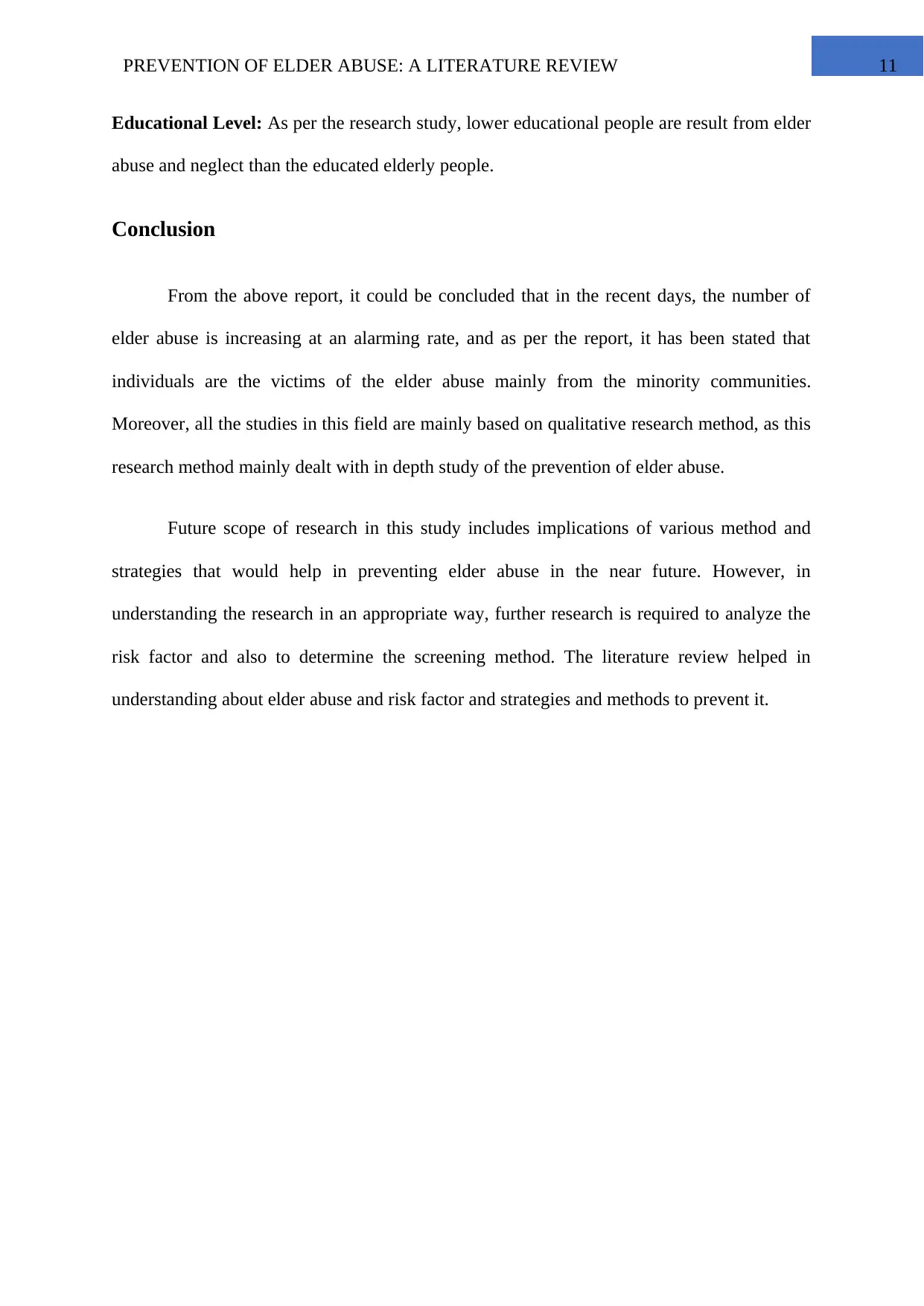
11PREVENTION OF ELDER ABUSE: A LITERATURE REVIEW
Educational Level: As per the research study, lower educational people are result from elder
abuse and neglect than the educated elderly people.
Conclusion
From the above report, it could be concluded that in the recent days, the number of
elder abuse is increasing at an alarming rate, and as per the report, it has been stated that
individuals are the victims of the elder abuse mainly from the minority communities.
Moreover, all the studies in this field are mainly based on qualitative research method, as this
research method mainly dealt with in depth study of the prevention of elder abuse.
Future scope of research in this study includes implications of various method and
strategies that would help in preventing elder abuse in the near future. However, in
understanding the research in an appropriate way, further research is required to analyze the
risk factor and also to determine the screening method. The literature review helped in
understanding about elder abuse and risk factor and strategies and methods to prevent it.
Educational Level: As per the research study, lower educational people are result from elder
abuse and neglect than the educated elderly people.
Conclusion
From the above report, it could be concluded that in the recent days, the number of
elder abuse is increasing at an alarming rate, and as per the report, it has been stated that
individuals are the victims of the elder abuse mainly from the minority communities.
Moreover, all the studies in this field are mainly based on qualitative research method, as this
research method mainly dealt with in depth study of the prevention of elder abuse.
Future scope of research in this study includes implications of various method and
strategies that would help in preventing elder abuse in the near future. However, in
understanding the research in an appropriate way, further research is required to analyze the
risk factor and also to determine the screening method. The literature review helped in
understanding about elder abuse and risk factor and strategies and methods to prevent it.
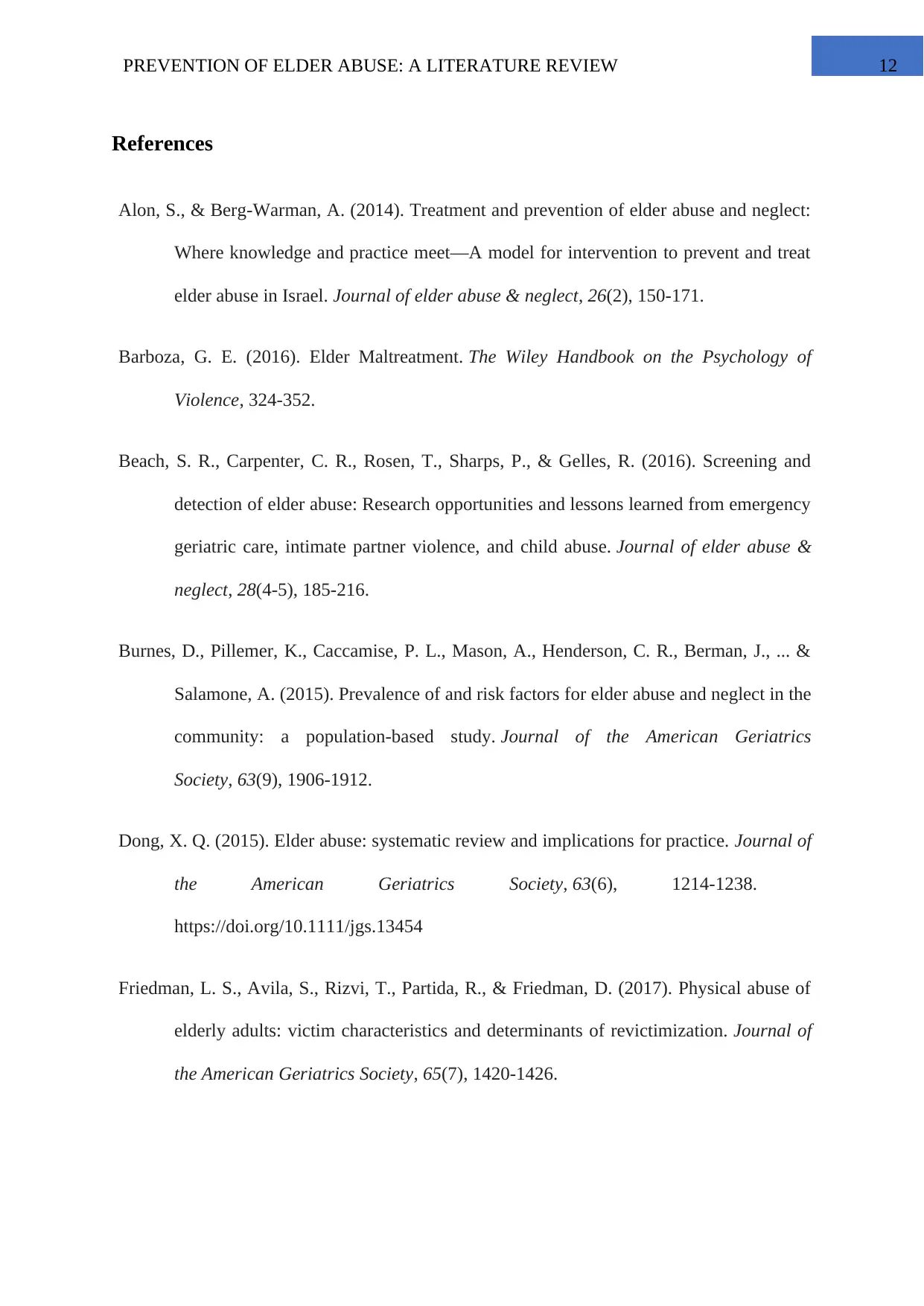
12PREVENTION OF ELDER ABUSE: A LITERATURE REVIEW
References
Alon, S., & Berg-Warman, A. (2014). Treatment and prevention of elder abuse and neglect:
Where knowledge and practice meet—A model for intervention to prevent and treat
elder abuse in Israel. Journal of elder abuse & neglect, 26(2), 150-171.
Barboza, G. E. (2016). Elder Maltreatment. The Wiley Handbook on the Psychology of
Violence, 324-352.
Beach, S. R., Carpenter, C. R., Rosen, T., Sharps, P., & Gelles, R. (2016). Screening and
detection of elder abuse: Research opportunities and lessons learned from emergency
geriatric care, intimate partner violence, and child abuse. Journal of elder abuse &
neglect, 28(4-5), 185-216.
Burnes, D., Pillemer, K., Caccamise, P. L., Mason, A., Henderson, C. R., Berman, J., ... &
Salamone, A. (2015). Prevalence of and risk factors for elder abuse and neglect in the
community: a population‐based study. Journal of the American Geriatrics
Society, 63(9), 1906-1912.
Dong, X. Q. (2015). Elder abuse: systematic review and implications for practice. Journal of
the American Geriatrics Society, 63(6), 1214-1238.
https://doi.org/10.1111/jgs.13454
Friedman, L. S., Avila, S., Rizvi, T., Partida, R., & Friedman, D. (2017). Physical abuse of
elderly adults: victim characteristics and determinants of revictimization. Journal of
the American Geriatrics Society, 65(7), 1420-1426.
References
Alon, S., & Berg-Warman, A. (2014). Treatment and prevention of elder abuse and neglect:
Where knowledge and practice meet—A model for intervention to prevent and treat
elder abuse in Israel. Journal of elder abuse & neglect, 26(2), 150-171.
Barboza, G. E. (2016). Elder Maltreatment. The Wiley Handbook on the Psychology of
Violence, 324-352.
Beach, S. R., Carpenter, C. R., Rosen, T., Sharps, P., & Gelles, R. (2016). Screening and
detection of elder abuse: Research opportunities and lessons learned from emergency
geriatric care, intimate partner violence, and child abuse. Journal of elder abuse &
neglect, 28(4-5), 185-216.
Burnes, D., Pillemer, K., Caccamise, P. L., Mason, A., Henderson, C. R., Berman, J., ... &
Salamone, A. (2015). Prevalence of and risk factors for elder abuse and neglect in the
community: a population‐based study. Journal of the American Geriatrics
Society, 63(9), 1906-1912.
Dong, X. Q. (2015). Elder abuse: systematic review and implications for practice. Journal of
the American Geriatrics Society, 63(6), 1214-1238.
https://doi.org/10.1111/jgs.13454
Friedman, L. S., Avila, S., Rizvi, T., Partida, R., & Friedman, D. (2017). Physical abuse of
elderly adults: victim characteristics and determinants of revictimization. Journal of
the American Geriatrics Society, 65(7), 1420-1426.
Paraphrase This Document
Need a fresh take? Get an instant paraphrase of this document with our AI Paraphraser

13PREVENTION OF ELDER ABUSE: A LITERATURE REVIEW
Gassoumis, Z. D., Navarro, A. E., & Wilber, K. H. (2015). Protecting victims of elder
financial exploitation: The role of an elder abuse forensic center in referring victims
for conservatorship. Aging & mental health, 19(9), 790-798.
Goldblatt, H., Band-Winterstein, T., & Alon, S. (2016). Social workers’ reflections on the
therapeutic encounter with elder abuse and neglect. Journal of interpersonal
violence, 0886260516633688.
Harries, P., Gilhooly, M. M., Gilhooly, K. J., & Davies, M. S. (2016). Enhancing Workforce
Capacity in the Detection and Prevention of Elder Financial Abuse. Public Policy &
Aging Report, 26(1), 30-33.
Hoover, R. M., & Polson, M. (2014). Detecting elder abuse and neglect: assessment and
intervention. American family physician, 89(6).
Lachs, M. S., & Pillemer, K. A. (2015). Elder abuse. New England Journal of
Medicine, 373(20), 1947-1956.
Mosqueda, L., Burnight, K., Gironda, M. W., Moore, A. A., Robinson, J., & Olsen, B.
(2016). The abuse intervention model: A pragmatic approach to intervention for
elder mistreatment. Journal of the American Geriatrics Society, 64(9), 1879-1883.
doi: 10.1111/jgs.14266
Namboodri, B. L., Rosen, T., Dayaa, J. A., Bischof, J. J., Ramadan, N., Patel, M. D., ... &
Platts‐Mills, T. F. (2018). Elder Abuse Identification in the Prehospital Setting: An
Examination of State Emergency Medical Services Protocols. Journal of the
American Geriatrics Society.
Gassoumis, Z. D., Navarro, A. E., & Wilber, K. H. (2015). Protecting victims of elder
financial exploitation: The role of an elder abuse forensic center in referring victims
for conservatorship. Aging & mental health, 19(9), 790-798.
Goldblatt, H., Band-Winterstein, T., & Alon, S. (2016). Social workers’ reflections on the
therapeutic encounter with elder abuse and neglect. Journal of interpersonal
violence, 0886260516633688.
Harries, P., Gilhooly, M. M., Gilhooly, K. J., & Davies, M. S. (2016). Enhancing Workforce
Capacity in the Detection and Prevention of Elder Financial Abuse. Public Policy &
Aging Report, 26(1), 30-33.
Hoover, R. M., & Polson, M. (2014). Detecting elder abuse and neglect: assessment and
intervention. American family physician, 89(6).
Lachs, M. S., & Pillemer, K. A. (2015). Elder abuse. New England Journal of
Medicine, 373(20), 1947-1956.
Mosqueda, L., Burnight, K., Gironda, M. W., Moore, A. A., Robinson, J., & Olsen, B.
(2016). The abuse intervention model: A pragmatic approach to intervention for
elder mistreatment. Journal of the American Geriatrics Society, 64(9), 1879-1883.
doi: 10.1111/jgs.14266
Namboodri, B. L., Rosen, T., Dayaa, J. A., Bischof, J. J., Ramadan, N., Patel, M. D., ... &
Platts‐Mills, T. F. (2018). Elder Abuse Identification in the Prehospital Setting: An
Examination of State Emergency Medical Services Protocols. Journal of the
American Geriatrics Society.
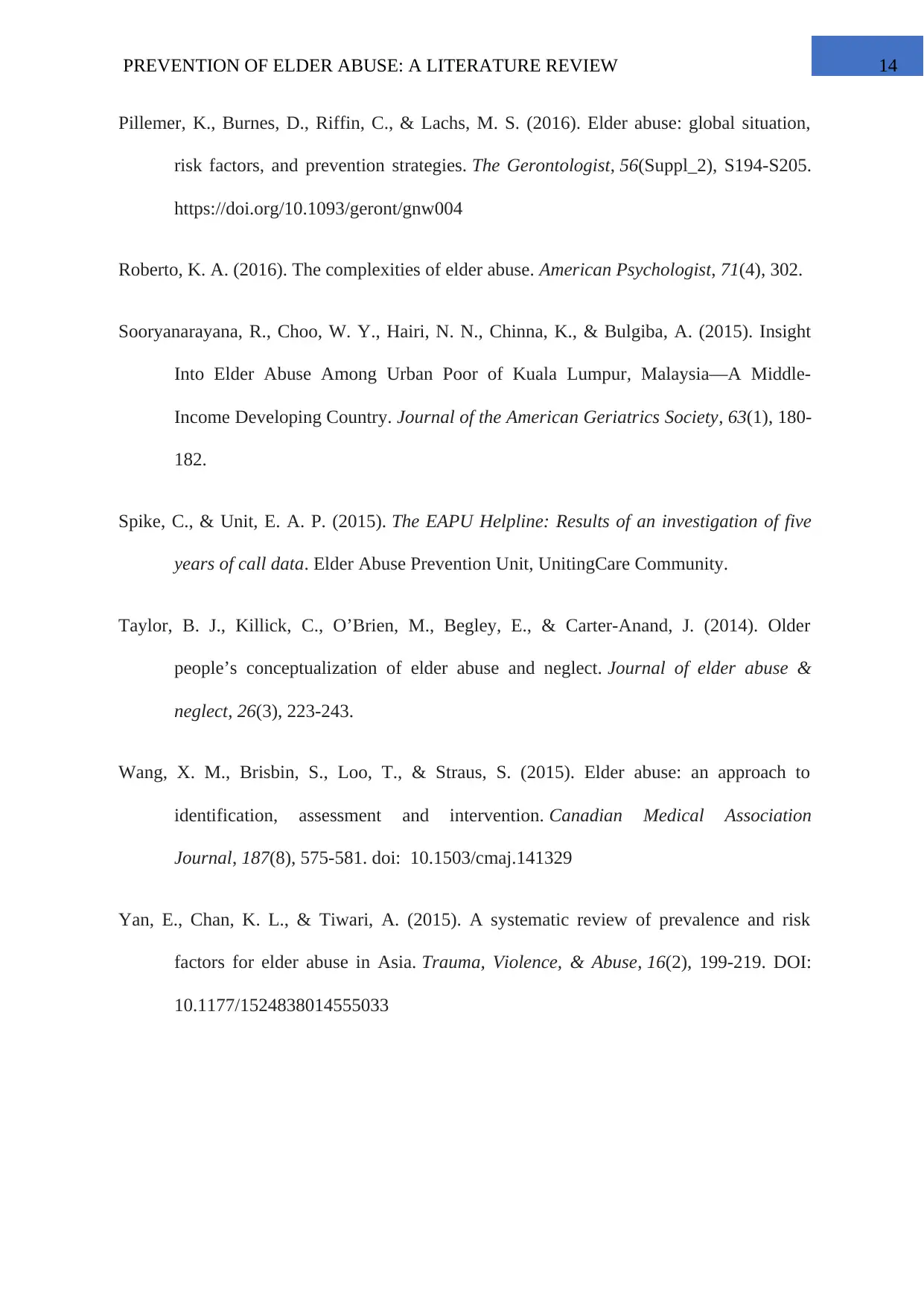
14PREVENTION OF ELDER ABUSE: A LITERATURE REVIEW
Pillemer, K., Burnes, D., Riffin, C., & Lachs, M. S. (2016). Elder abuse: global situation,
risk factors, and prevention strategies. The Gerontologist, 56(Suppl_2), S194-S205.
https://doi.org/10.1093/geront/gnw004
Roberto, K. A. (2016). The complexities of elder abuse. American Psychologist, 71(4), 302.
Sooryanarayana, R., Choo, W. Y., Hairi, N. N., Chinna, K., & Bulgiba, A. (2015). Insight
Into Elder Abuse Among Urban Poor of Kuala Lumpur, Malaysia—A Middle‐
Income Developing Country. Journal of the American Geriatrics Society, 63(1), 180-
182.
Spike, C., & Unit, E. A. P. (2015). The EAPU Helpline: Results of an investigation of five
years of call data. Elder Abuse Prevention Unit, UnitingCare Community.
Taylor, B. J., Killick, C., O’Brien, M., Begley, E., & Carter-Anand, J. (2014). Older
people’s conceptualization of elder abuse and neglect. Journal of elder abuse &
neglect, 26(3), 223-243.
Wang, X. M., Brisbin, S., Loo, T., & Straus, S. (2015). Elder abuse: an approach to
identification, assessment and intervention. Canadian Medical Association
Journal, 187(8), 575-581. doi: 10.1503/cmaj.141329
Yan, E., Chan, K. L., & Tiwari, A. (2015). A systematic review of prevalence and risk
factors for elder abuse in Asia. Trauma, Violence, & Abuse, 16(2), 199-219. DOI:
10.1177/1524838014555033
Pillemer, K., Burnes, D., Riffin, C., & Lachs, M. S. (2016). Elder abuse: global situation,
risk factors, and prevention strategies. The Gerontologist, 56(Suppl_2), S194-S205.
https://doi.org/10.1093/geront/gnw004
Roberto, K. A. (2016). The complexities of elder abuse. American Psychologist, 71(4), 302.
Sooryanarayana, R., Choo, W. Y., Hairi, N. N., Chinna, K., & Bulgiba, A. (2015). Insight
Into Elder Abuse Among Urban Poor of Kuala Lumpur, Malaysia—A Middle‐
Income Developing Country. Journal of the American Geriatrics Society, 63(1), 180-
182.
Spike, C., & Unit, E. A. P. (2015). The EAPU Helpline: Results of an investigation of five
years of call data. Elder Abuse Prevention Unit, UnitingCare Community.
Taylor, B. J., Killick, C., O’Brien, M., Begley, E., & Carter-Anand, J. (2014). Older
people’s conceptualization of elder abuse and neglect. Journal of elder abuse &
neglect, 26(3), 223-243.
Wang, X. M., Brisbin, S., Loo, T., & Straus, S. (2015). Elder abuse: an approach to
identification, assessment and intervention. Canadian Medical Association
Journal, 187(8), 575-581. doi: 10.1503/cmaj.141329
Yan, E., Chan, K. L., & Tiwari, A. (2015). A systematic review of prevalence and risk
factors for elder abuse in Asia. Trauma, Violence, & Abuse, 16(2), 199-219. DOI:
10.1177/1524838014555033
1 out of 15
Related Documents
Your All-in-One AI-Powered Toolkit for Academic Success.
+13062052269
info@desklib.com
Available 24*7 on WhatsApp / Email
![[object Object]](/_next/static/media/star-bottom.7253800d.svg)
Unlock your academic potential
© 2024 | Zucol Services PVT LTD | All rights reserved.





